|
It had only been a little over two weeks since the last winter
camping trip when I found myself driving north again to play
in the snow. I had made some final adjustments on my sled
and, with the recent adventure under my belt, I was pretty
confident that I was ready for this one.
I reached Shingleton just in time to get a final hot meal
and fill my water bottles. (Most of the U.P. closes shortly
after dark.)
From there I drove through the sleeping village of Van Meer
and past the Bear Trap Inn, which definitely was not closed.
Its large parking lot was filled with snowmobiles and more
were circling looking for a place to land. It was easy to
see why they were so concentrated here: the lake-effect snow
north of M-28 was about the only white stuff I'd seen since
leaving Flint.
The pre-trip bivouac was to be wherever the plows turned
around on CR 620, which winds through the woods north of Melstrand,
past a number of private cottages and out to Chapel Beach.
Trip leader Michael Neiger had said his information indicated
that the road would only be plowed a couple of miles.
I had driven much further than that when I reached the turn
around. There was a truck parked there but it wasn't Michael's.
Suspecting that it belonged to Ed Pavwoski, the third member
of our group, but still unsure that I was in the right place,
I started back up the road to double check. I hadn't gone
far when I encountered Michael's red Ford Explorer headed
in the opposite direction and I followed him back to the turn
around.
We got out and exchanged a few words of greeting, but it
immediately became apparent that getting some insulating layers
on was a priority. When I had trouble handling the side zips
on my pants I said, "Wow! This air is mean! How cold
is it anyway?"
Michael set out a thermometer, which soon read -30 F. We
surveyed the camping possibilities and selected a couple of
spots just over the berm. There we packed the snow down a
little and spread out our bags. I stashed my water bottles
in the bag so they wouldn't freeze and decided to walk around
a little to generate some body heat for the night.
I followed Ed's trail a bit but he was WAY back in the woods...
Returning to my bag, I took off my mukluks and slid in, pulling
the draw cords 'til the hood was snug around my face. The
night was very clear and the sky was filled with stars like
you never see in town. Despite the slight residual chill in
my bag I was sure this was where I wanted to be.
Thursday morning dawned sunny but still very cold. I had
to apply some leverage to the screw cap on my fuel bottle--it
was "vacuum sealed" even though it had been filled
in an unheated garage at -10 F. Once in the stove the alcohol
required several minutes of heating over a candle before it
would ignite. Fingers weren't useful for very long outside
of their mittens either...
While we were fixing breakfast, Ed appeared from his bivouac
in the woods wondering if we were ready to go yet: he's always
been an early riser. It was good to see him again.: He'd not
been on a trip with us since last winter as bicycling is his
thing in the warmer months.
We assembled our gear and packed it into the sleds and spotted
Ed's truck where we hoped to finish the hike. The preliminaries
being accomplished, we struck off through the hardwoods, bushwhacking
in the direction of the Little Miners River and a cave Michael
had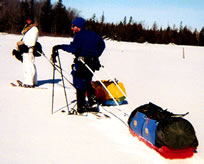 discovered several years before.
discovered several years before.
Michael Neiger
of Marquette, Michigan
and Ed Pavwoski
of Lansing, Michigan
pull their sledges
across a frozen wetland
en route to the
Amphitheater Cave in
Miners Basin.
(Photo by Mary Powell)
He called it "the Amphitheater" because of its
size and shape--like half a inverted bowl, 50 feet high and
160 feet across. We had visited it once in the summer and
had seen the Little Miners spilling over the top into a pool
in the middle of the floor. We were anxious to see how it
looked at this time of year with the waterfall probably frozen.
Travel through the hardwoods was pleasant and we reached
the vicinity of the cave around mid-afternoon. The approach
we'd used in the summer, along the escarpment, had been rendered
too hazardous to use by loose drifted snow and patches of
ice.
We scouted around a little and found a way to get down the
steep slope beneath the cliff and approach the cave from below.
We used a rope for a more controlled descent, not really sure
that it was necessary. Later however, when we began to climb
back up, we were very glad it was there.
Approaching the cave from the front we had an awesome view
of the 50-foot column of ice that the waterfall had created.
We climbed around the base of this tower and found it had
some hollow channels beneath its surface where the water still
flowed with a muffled gurgling sound. 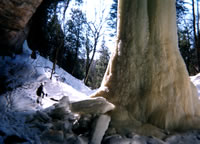
Michael Neiger
of Marquette, Michigan
exits the entrance to
the Amphitheater Cave
alongside the frozen,
50-foot column of ice
formed by the
Little Miners River.
(Photo by Mary Powell)
Seeps along the back of the cave had covered the rock with
rows of gigantic icicles. The afternoon sun provided great
lighting for pictures and we spent quite a while exploring
and photographing this frozen cave.
We expended quite a bit of energy getting back up the hill
to our sleds and might have been content to settle nearby
had the rules of the park not required that we camp only in
campgrounds.
We fastened our waistbelts, picked up our ski poles and headed
for the Potato Patch campground. The rim of the basin seemed
to go on forever, but eventually we approached the cliffs
and could see the frozen surface of Lake Superior between
the trees.
The campground was rather mundane in the summer, but totally
deserted and covered with a deep blanket of snow in the winter,
it was quite beautiful. After choosing our sites from the
many that were available, we walked to an overlook to view
the lake in the little daylight that was left.
It reminded me of pictures of lunar landscapes--large smooth
areas interrupted by irregular ridges of ice. There were a
number of volcano-like formations that are created early in
the winter as waves smash against the pack ice eroding caves
that end in vertical tubes from which the water shoots, forming
small mountains of ice around the opening where it lands and
freezes.
We returned to the campsites to put up our shelters, stopping
at intervals during this endeavor to enjoy the pastel winter
sunset over the lake. A peaceful evening followed, much warmer
than the night before. By the time we finished the evening
meal, the stars were out and a crescent moon had risen.
Friday morning we awoke to cloudy skies and a light snow
falling. A little fog hung in the campground and softened
the edges of the cliffs in the distance, obscuring some of
them completely. The landscape was a study in shades of gray,
like a black and white photograph.
By the time we finished breakfast a gusty breeze was blowing
and patches of blue had appeared in the sky. We started along
the cliffs, following the trail to Mosquito Beach. Travel
was not difficult but the steady wind from the lake made it
feel much colder than it actually was.
Approaching Mosquito Beach the trail drops gradually at first
then comes abruptly to the top of a wooden staircase....at
least we figured the steep zigzagging descent must be a staircase
as there was an occasional board visible in the deep drifts.
Michael thought a nearby ravine might be a better way to
get down. He told us to wait a minute and disappeared over
the edge. The first few seconds were quiet, then there were
sounds of crashing brush and muffled exclamations. We waited.
After a minute or so of quiet, Michael appeared at the bottom
of the hill (amazingly still followed by his sled) and told
us to take the stairs. This we did very carefully--a runaway
sled weighing 70-80 pounds is a definite hazard.
Proceeding across the beach atop the ridge of pressure ice,
we could see there were others here: a couple of human figures
could be seen moving on the far side. (We later encountered
this rather taciturn pair on the trail and exchanged greetings
but they weren't inclined to chat.)
We came upon one of the volcano-like formations such as we'd
seen the evening before--a cone shaped hill of ice with its
"crater" filled with fluffy snow. Michael probed
it with his ski pole and it sank with almost no resistance.
I volunteered to step in and see how deep it was. Normally
fairly constrained in expressing an opinion, Michael said,
"Are you NUTS!? That could be VERY deep!" Later,
I saw what he meant.
The huge ice formations on the beach begged to be explored,
but we decided to pick out an area to camp in first and to
leave the sleds there. We chose a site a little back from
the shore--one that gave us shelter from the wind.
Unbuckling our sleds, we took our cameras and headed for
the beach. As we emerged from the woods we spotted a brightly
colored tent atop the nearest ice formation. Braving the elements
on that exposed perch was a young man who waved cheerfully
to us as we moved toward him.
After exchanging greetings (we learned his name was Alex)
Michael asked him if he had something to secure the tent to
the ice, explaining that the winds along the shore are very
unpredictable, often reaching high velocities rather quickly.
He also asked Alex if he'd like to come with us to look at
the ice formations. Alex said that when he got his tent squared
away he would join us.
We moved down the beach, checking out the ice structures
sculpted by early winter storms. In a bay area like this,
before it freezes solid, the waves break up the sheets of
ice that form on top of the water and, aided by the wind,
pile the fragments along the shore. Then the piles are eroded
by the wind and waves, coated repeatedly with spray and decorated
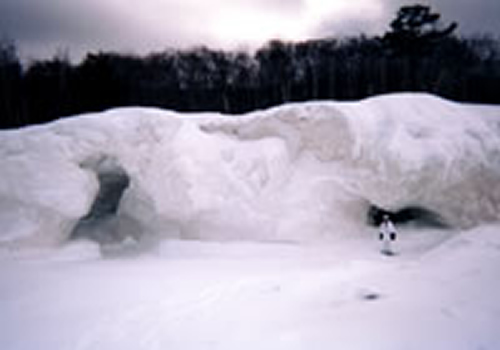 withlayers
of snow. withlayers
of snow.
Mary Powell
of Flint, Michigan
explores the 30-foot-high
ice formations along the
Lake Superior shoreline
at Mosquito Beach.
(Photo by Mary Powell)
The large windswept hills covered by drifting snow resembled
sand dunes in the Sahara--a person atop one is dwarfed by
its size. We found caves of varying sizes and huge crevasses
along the cliff of ice.
Several caves were big enough to go into and one had a ledge
inside where you could stand and look up the open "chimney."
Gazing at the sky visible through the opening more than thirty
feet above me, I thought about what might have happened if
I'd stepped into the one filled with snow....
We took quite a few pictures before heading further down
the shore to Lover's Leap, a rock arch that reaches up to
the cliff top. We explored it and took some more pictures
before heading back to the campground, arriving just as darkness
set in.
Alex hadn't caught up with us along the ice ridge and as
we entered the woods we saw his tent dug in among the pines.
Apparently he'd decided that "discretion is the better
part of valor." We invited him to join us for breakfast.
We spent the evening relaxing. The Spartans were right in
saying that hunger is the best seasoning for food--dinner
was great! There was very little wind among the evergreens.
After the meal, I sat back in the snow lounger I'd dug and
read for quite awhile. On a walk down to the beach before
turning in I found a steady wind tugging at the trees and
erasing our trail with drifts of snow.
Saturday's plan was to hike from Mosquito to Chapel Beach.
Again the steady wind from the lake made it feel colder than
it was. After awhile we decided to bushwhack through the woods
instead of following the trail along the cliffs in the wind.
Alex had joined us as he was running low on supplies and
his car was in that direction. Along the way we found the
remains of a porcupine that had become dinner for some other
forest inhabitant-unusual because there are not many animals
that can kill a porcupine.
The approach to Chapel, as at Mosquito, has a steep incline.
This time we lowered the sleds one at a time with a rope.
On the beach was a large area of open water behind the low
ice ridge that had formed there.
Apparently the higher temperatures of the water seeping steadily
from the ground was enough to maintain the thawed area. We
negotiated the jumble of huge ice slabs to walk into the huge
cove at the beginning of Battleship Row.
Having swam into the cove the summer before and seen the
motion of the waves against the rock walls and the clear deep
water illuminated by shafts of sunlight, as well as heard
the constant sound of waves and dripping water, I found it
strange to see the cove so gray, unmoving, and silent.
Eastward down the beach were other attractions. The waves
of early season storms repeatedly pound the cliff there coating
them with ice. Even the trees on top of the cliff, more than
a hundred feet above the water, were covered with ice from
the spray.
The result was a giant fairy castle of ice tinged with varying
colors: white, pale turquoise, rusty orange, pink and lavender.
Again the light was good and I used up quite a bit of film.
After finding a campsite and getting set up, we enjoyed another
pleasant evening. Alex talked of the places he'd been and
listened to some of our stories in return.
We learned that, among other things, he'd worked as a photographer--a
useful talent on wilderness trips where there are so many
beautiful things to capture on film. He was good company too
and we hoped he could join us on a future trip.
Michael and Alex spent part of the evening trying without
success to fix Alex's stove, which was refusing to light.
Alex then traded Michael some fuel for some hot water.
Snug in my shelter after dinner, I read for awhile and listened
to the gusty wind harassing the trees.
Sunday started out well--the sun was shining--but it didn't
go exactly as planned. After breakfast we followed the river
to the outlet of Chapel Lake. Our objective was to visit a
series of old sea caves along the escarpment overlooking the
lake.
Working our way along the shore near the outlet Michael checked
the ice frequently to make sure it was solid. In spite of
this, at one point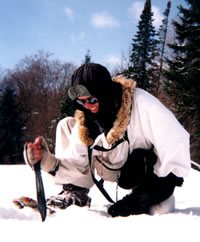 Ed broke through.
Ed broke through.
Michael Neiger
of Marquette, Michigan
checks the ice for thickness
with a knife
at the outlet
of Chapel Lake.
(Photo by Alex Chard
& Mary Powell)
This necessitated a hasty scramble to get him and his sled
out of the water and get the slush off his boots and pants.
We also dumped a couple of gallons of lake water out of his
sled and scraped the ice from its bottom.
On the move again, the lake widened out before us. Despite
a cold breeze the warmth of the sun could be felt and travel
over the smooth expanse was easy.
When a scree slope came into view below the escarpment to
the west, Michael said it was time to have a look at the caves.
That meant climbing about a hundred feet up a high-angle slope
in deep sugary snow...
We parked the sleds near the shore and got the rope out again.
We picked our way up, zigzagging between rocks and vegetation
that gave us some purchase on the slope.
We used the rope to get over a short near-vertical section.
Once at the escarpment it became apparent that we were not
going to be able to walk easily along the ledge as we had
in the summer. As at the Amphitheater cave, seeps had covered
the ledge with sheets of ice in many places.
Michael did a bit of recon and determined that we would not
be able to reach "Raptor" cave (the largest of the
series) within our time limitations.
We contented ourselves with looking in the small ones close
by and having lunch on the ledge with a great overview of
Chapel Lake. Climbing back down was easier than going up and
we were soon back to our sleds.
A little more snowshoeing brought us to the end of the lake
and the end of easy travel. In front of us was a swamp that
looked quite impassable but Michael barely paused before disappearing
into the brush.
Alex followed. Ed's sled wasn't behaving well and he decided
to make a few adjustments.
It was several hours before we saw Michael and Alex again
though we could sometimes hear their voices far ahead. At
one point Michael found the remains of a raccoon cached in
the snow by whatever had killed it. Always thoughtful he left
a tuft of the fur near their trail so that Ed and I would
see the find too.
Michael was trying to get Alex back to an established trail
so that he could get to his car before dark as he had to be
at work the next day.
Eventually the swamp gave way to woods and we came upon Michael
and Alex taking a short break where they had found the trail.
Another mile or so brought us to the unplowed Chapel parking
area.
After farewells Alex headed toward his car. The rest of us
didn't have far to go as we planned to camp in the buffer
zone just up the road. We walked a ways and chose a spot in
the hardwoods.
Ed started to dig in, commenting, "You know, I never
shovel snow at home...."
I dug a small rectangle throwing the snow around the edges
to make walls over which I tied my tarp. Michael did much
the same but his excavation matched the size of his tarp much
better than mine did...maybe when I've had another twenty
years of practice...
The usual evening routine followed: boil water, cook dinner,
melt snow to make more water for the next day.
Ed turned in early and Michael was very quiet. I read a little
but then just sat back to watch the sliver of moon come up
in the hazy sky. I was tired of pulling the sled but not really
ready for the trip to be over.
The next morning we packed our gear into the sleds one more
time. Ed was still well supplied with food and gave me a gallon
zip-lock of his excellent trail mix and some venison jerky.
"For your next trip," he said, knowing it wouldn't
get stale as I was driving from this trip to Minnesota to
try dogsledding.
The trek to his truck was all uphill and seemed to take a
long time, but the hardwoods in their blanket of snow were
very pretty. When we had collected our cars and stowed our
gear, we adjourned to the Bear Trap Inn (still busy with snowmobilers)
for lunch--where we spent the time talking about next winter's
trips....
Read
another journal...
|


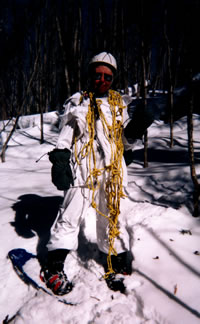
 discovered several years before.
discovered several years before.
 withlayers
of snow.
withlayers
of snow. Ed broke through.
Ed broke through.